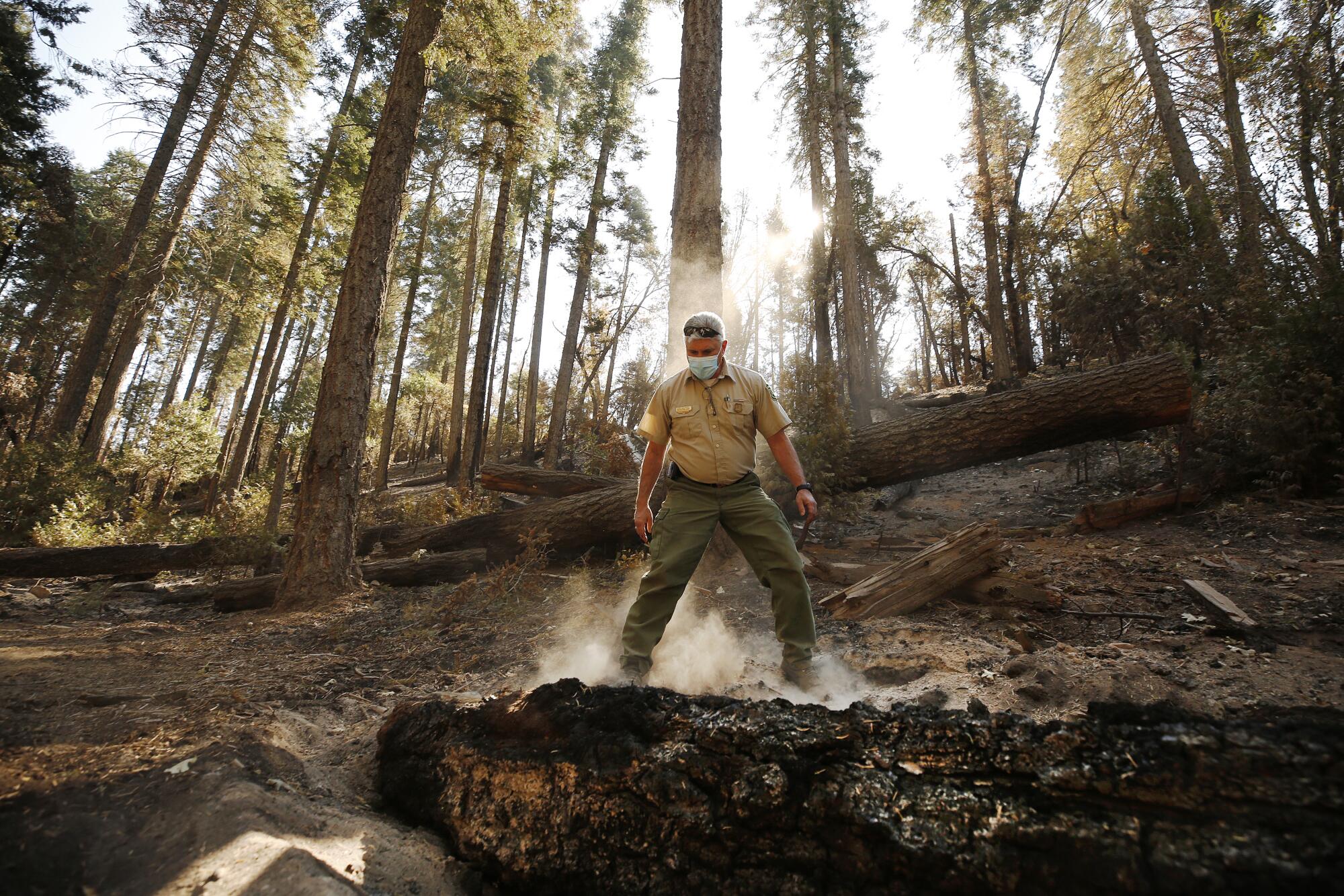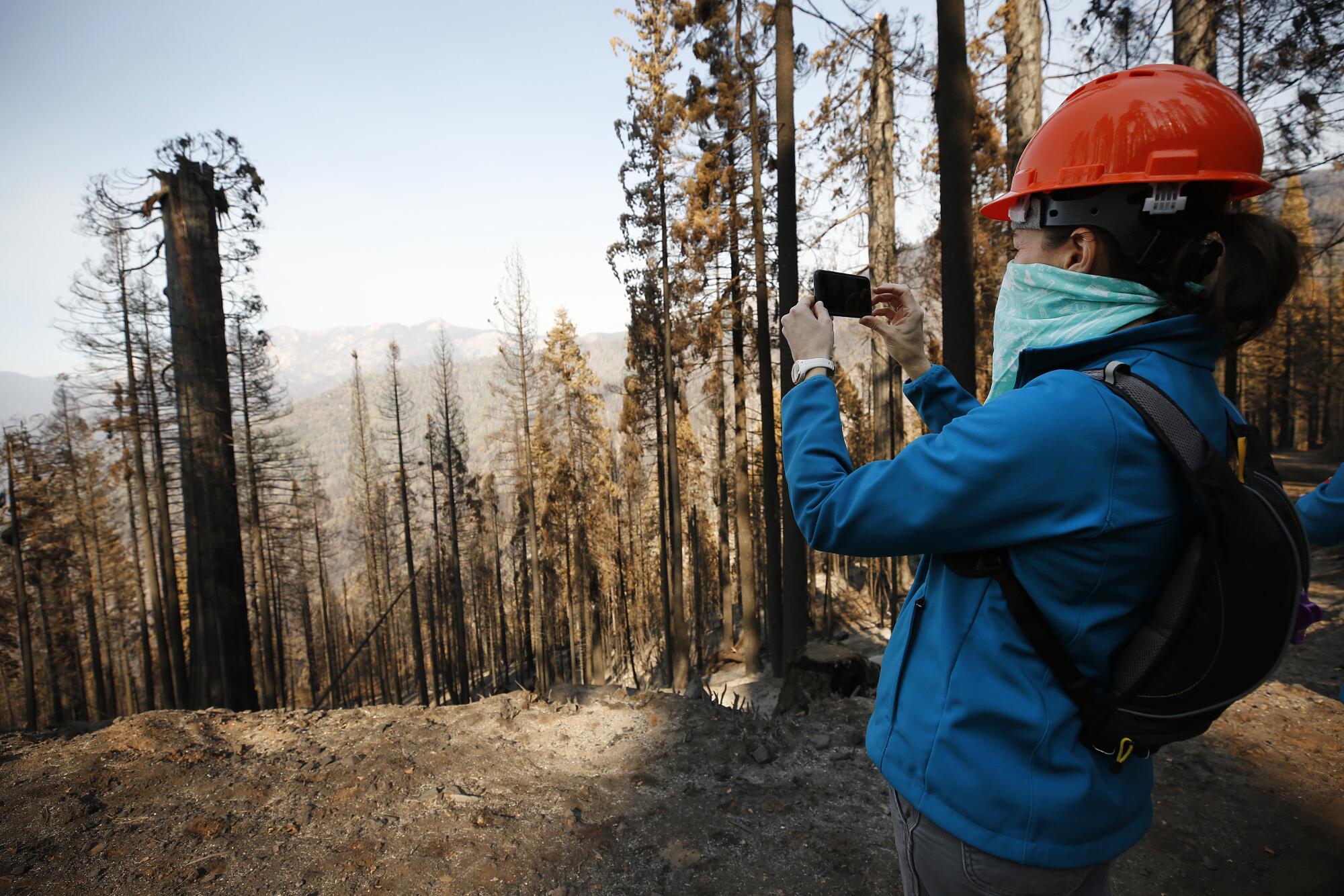
- Share via
SEQUOIA CREST, Calif. — Kristen Shive glanced around the blackened forest and started counting.
She stopped at 13 — the number of giant sequoias she spotted with charred trunks, scorched crowns and broken limbs.
The towering trees had grown on this Sierra Nevada ridge top for well over 500 years. They had lived through many wildfires and droughts. But they could not survive the Castle fire, which swept into the Alder Creek Grove in the early hours of Sept. 13.

One of the monster wildfires birthed by California’s August lightning blitz, the Castle fire burned through portions of roughly 20 giant sequoia groves on the western slopes of the Sierra, the only place on the planet they naturally grow.
Sequoia experts may never know how many of the world’s most massive trees died in the Castle fire, but judging by what they have seen so far, they say the number is certainly in the hundreds — and could easily top 1,000.
“This fire could have put a noticeable dent in the world’s supply of big sequoias,” said Nate Stephenson, a research ecologist with the U.S. Geological Survey.
The Castle fire is just the latest in a string of wildfires since 2015 that have fried monarch sequoias — trees that nature designed to not only withstand fire but thrive with it.

They are armored with thick bark. Their high branches are out of reach of most flames. Their cones — no larger than a chicken egg — release seeds when exposed to a burst of heat.
The problem is that the wildfires chewing through sequoia groves these days are not the kind that the long-lived giants evolved with.
A century of fire suppression, the 2012-16 drought and rising temperatures have combined to produce more intense fires that are taking an alarming toll on the copper-hued behemoths.
Shive had been watching the growth of the Castle fire since it started Aug. 19 with a lightning strike on the edge of the Golden Trout Wilderness in the Sequoia National Forest.

By the weekend of Sept. 12, it had spread westward to the doorstep of the 530 acres of the privately owned Alder Creek grove that the Save the Redwoods League purchased less than a year ago.
“We thought we were in the clear; the fire was on the other side of the ridge,” said Shive, the conservation group’s science director.
But the fire made a major run that Sunday morning, blasting down drainages as 60-mph winds pushed flames into the grove’s southern end.
Shive spent much of the day on the phone, gathering information about fire behavior and studying maps. She knew the Castle fire had burned extremely hot in places and figured they’d lost some monarchs.

But when she drove the grove’s dirt roads a few weeks later, she was shocked by what she saw in some places.
Old sequoias can survive even if just 5% of their crowns remain green and unscorched by a fire’s heat. There was no green on the sequoias Shive counted on the ridge west of Jordan Peak.
Their broccoli tops were roasted. One giant was decapitated, the upper trunk and branches strewn at its base in a tangled heap.
There were more bleak scenes elsewhere. The league estimates that on its property alone, the Castle fire killed at least 80 monarchs, ranging in age from 500 years old to well over 1,000 years old.

“We shouldn’t have lost so many. I think it’s unacceptable,” said Shive, a former fire ecologist with the National Park Service.
In Sequoia Crest, a small vacation-home community developed in the grove in the 1960s, chimneys and foundations are all that remain of about a third of its 104 houses.
It wasn’t all doom and gloom. Remote-sensing satellite images indicate that much of the league’s Alder Creek land didn’t burn in the Castle fire or experienced light fire that will do some ecological good.
One of those good burns was in the vicinity of the grove’s star, the 3,000-year-old Stagg tree, the fifth-largest giant sequoia on record.

As tall as a 25-story building and wider than a two-lane road, the Stagg remained untouched with the help of a hose sprinkler system laid around its base by firefighters.
Near the Stagg, the Castle fire did a bit of forest housekeeping, burning undergrowth, young white fir trees and incense cedars. Seventy feet of black trunk traced the path of flame on a younger sequoia, but “I don’t think it will even notice,” Shive said.
At another spot in the grove, Shive pointed to little sequoia seeds that newly opened cones had showered on the ash-coated ground. “I suspect we’re going to have a lot of regeneration,” she said.

Technically considered part of the SQF Complex fire because it started near another, small lightning fire, the Castle fire burned almost all of the fire complex’s 171,000 acres. Three-quarters of that acreage was in the Giant Sequoia National Monument and Sequoia National Forest, which surround the Alder Creek grove.
About 19,000 acres are in the southern edge of Sequoia National Park, which abuts the monument.
“Nobody was really worried” about the Castle fire in its first weeks, said Christy Brigham, science chief of Sequoia and Kings Canyon National Parks. “We have a lot of lightning fires. I was not overly concerned.”

In early September, the Castle fire made some major runs toward the parks.
“At that point, we started to think it could get into some of our sequoia groves,” Brigham said. “But I still had the mental model that these trees are very fire adapted.… This is going to be OK from the sequoia perspective.”
That notion began to fade as she heard more about the Castle fire’s erratic behavior. Then, last month, the parks’ fire ecologist, Tony Caprio, sent Brigham an aerial drone photo of a badly burned grove called Homers Nose.
Caprio had marked it with little red dots: They were giants whose entire crowns had been incinerated.

“To see those giant sequoia, monarch, blackened toothpicks was a gut punch,” Brigham recalled.
When big sequoias die in a wildfire, it is usually because heat has scorched all their needles, which are still on the tree. This was different. All-consuming flame had turned the giants into sequoia skeletons.
The first time the USGS’ Stephenson heard of combusted sequoia tops was in the 2015 Rough fire, another big lightning blaze in the Sierra that burned into sequoia groves.
Char marks in the tree-ring corings of ancient sequoias show that before the arrival of settlers in the mid-1800s and the government’s 20th century anti-wildfire policies, low- to moderate-intensity fires ignited by lightning and Native Americans skipped through the groves every 10 to 30 years.

At times they flared into small, high-intensity burns that created openings for a new generation of sequoias to take hold. Occasionally a monarch died.
The big exception to that pattern was 1297, a year that stands out in the sequoia tree-ring record as a time of high-severity fire. It was during the Medieval Warm Period, an era of hotter temperatures in some parts of the world, including the Sierra.
The 2020 Castle fire, Stephenson said, is probably worse than 1297.
He cites two main causes: climate change, which exacerbates fire conditions, and the banishment of regular flame, which has left Sierra forests denser than they were pre-settlement.

“It’s both,” he said. “If fire hadn’t been excluded from those groves for so long, the fire effects probably would have been a lot less severe. Just that buildup of fuel.
“We could see a lot more of this severe fire behavior in the future,” he warned. “That has really shaken me up and shaken others up into thinking we have to do a much better job of protecting these groves.”
How? By ramping up controlled burns, he said, and thinning thick young stands of white fir and incense cedar near communities and roads.
As evidence of how that helps, he described a trail in Kings Canyon park that runs through a portion of the Grant Grove that burned five years ago in the Rough fire.

On the side of the trail where the park had conducted controlled burns, one giant died in the Rough fire. On the other side, where no prescribed burning had occurred, the fire killed more than 15 big sequoias.
The National Park Service was the first federal agency to recognize the ecological harm of fire exclusion, and Sequoia-Kings Canyon staff have been lighting controlled fires in the groves since the 1960s.
But they had never gotten to the relatively remote park groves that burned the hottest in the Castle fire — Homers Nose, Board Camp and Cedar Flat.
Brigham has known since she arrived in Sequoia-Kings Canyon five years ago that the parks’ average of 1,000 acres a year of controlled burns is not enough.

Now she has a new sense of urgency, realizing that “if we don’t get prescribed fire in those groves that have not had any for 100 years, we lose 2,000-year-old monarchs in a fire.”
Eric La Price and George Powell turned off Highway 190 and parked on a dirt road. The thumping of a lone helicopter overhead broke the eerie quiet.
There were no sounds of life on this fire-ravaged mountainside in the McIntyre Grove, one of the monument areas hardest hit by the Castle fire.
The charred corpse of a giant sequoia poked into the smoky haze. All around it were black sticks, the ruins of 50- to 70-year-old conifers that Powell guessed had grown in after an old logging operation.

“To us, this is atypical that we’d have areas that burned so severely and were so large in size,” said Powell, the Sequoia National Forest ecosystem manager.
Black oaks will re-sprout, but with no surviving green conifers to drop seeds, he predicted the slope would turn into shrub fields.
“Every year we talk about how we need to do more work in the groves,” said La Price, the Sequoia National Forest’s Western Divide District ranger. Then he ticked off the reasons why they didn’t.
The forest doesn’t have the money or the staff. “We barely have a budget to keep the lights on,” he said.
He noted the more than $100 million it has cost the government to fight the Castle fire. “Imagine if we had $107 million to do reforestation, thinning and prescribed fire,” he said wistfully.
Money is not the only problem. There’s little market for the smaller trees in most need of thinning. And then there’s the public’s dislike of smoke from controlled burns.
People don’t just complain to him, La Price said. They call up their congressional offices, which then tell the forest: Don’t let the burns go on too long.
But one way or another, there’s going to be smoke in the Sierra.
“More and more fire is going to happen on the landscape,” Shive said. “We need to decide what kind of fire we want. Do we want fire that is healthy and restorative in our ecosystems, or what we had this year?”







